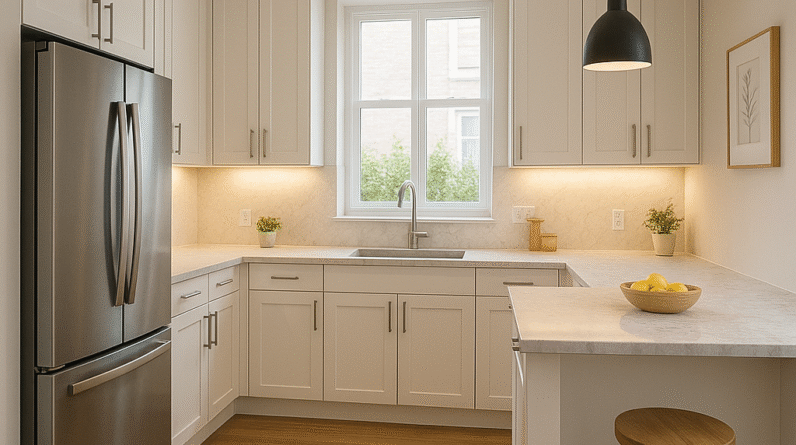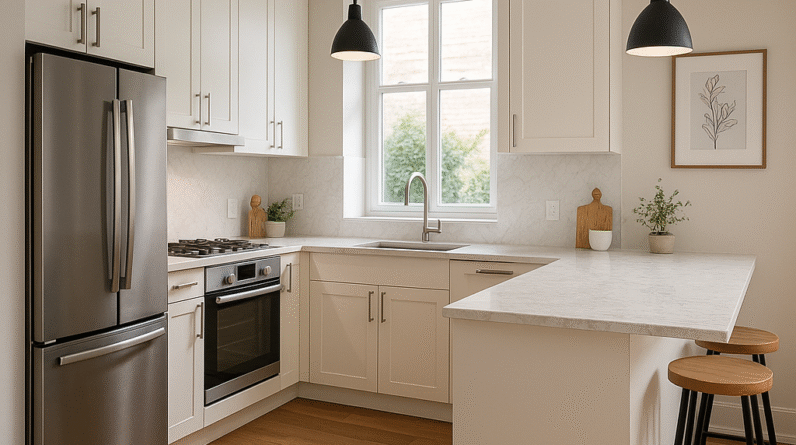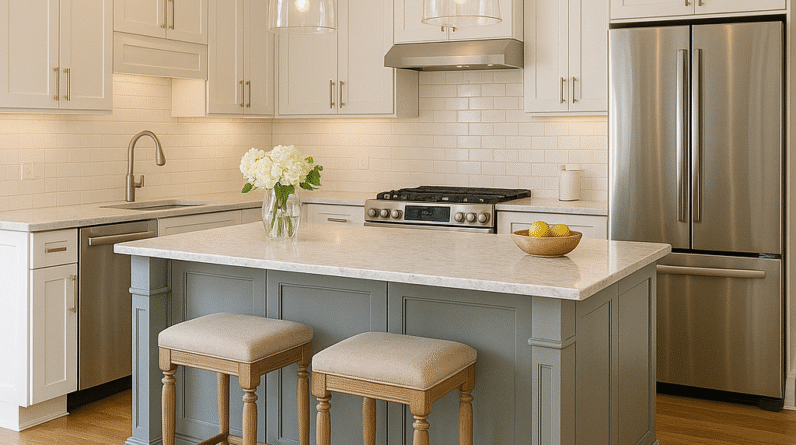
What Is A Very Small Kitchen Called?
Have you ever wondered what a very small kitchen is called? Well, you’re about to find out! In this article, we will explore the term used to describe those tiny cooking spaces that require a bit of creativity to make the most of. So, if you’re curious to learn the name for these petite culinary havens, keep reading!

Micro Kitchen
Definition of a Micro Kitchen
A micro kitchen is a compact and highly efficient kitchen space designed for small living areas or limited square footage. It is designed to maximize functionality and minimize the use of space, allowing you to have essential kitchen amenities within a small footprint.
Features of a Micro Kitchen
Micro kitchens typically include essential appliances such as a small refrigerator, a two-burner cooktop or induction cooktop, a sink with faucet, and some storage space for utensils and cookware. The design of a micro kitchen focuses on maximizing vertical space utilization by incorporating overhead cabinets or shelves, as well as utilizing multi-functional furniture pieces.
Advantages and Disadvantages of a Micro Kitchen
One of the major advantages of a micro kitchen is its space-saving nature, making it ideal for small apartments, tiny homes, or even office spaces. It allows you to have a functional kitchen without sacrificing a significant amount of space. Micro kitchens are also more cost-effective compared to larger kitchens, as they require fewer materials and appliances.
However, the limited space in a micro kitchen can also pose some challenges. Storage space is often limited, which can make it difficult to organize and store all necessary kitchen items. Cooking in a micro kitchen may sometimes feel cramped, and you may need to be creative with your cooking techniques to accommodate for the limited counter space.
Compact Kitchen
What is a Compact Kitchen?
A compact kitchen is similar to a micro kitchen in terms of space-saving design, but it typically offers slightly more countertop space and storage options. While it shares the same goal of maximizing functionality within a limited space, a compact kitchen provides a bit more room for meal preparation and storage of kitchen essentials.
Characteristics of a Compact Kitchen
A compact kitchen typically includes a small refrigerator, a four-burner gas or electric cooktop, a sink with faucet, and more storage space compared to a micro kitchen. It may also feature additional amenities such as a built-in microwave or dishwasher. The design of a compact kitchen often utilizes smart storage solutions, such as pull-out cabinets or vertical shelves, to maximize the use of available space.
Benefits of a Compact Kitchen
The main benefit of a compact kitchen is that it provides a more comfortable cooking experience compared to a micro kitchen. The additional countertop space allows for easier meal preparation and a wider range of cooking techniques. The increased storage options also make it easier to keep the kitchen organized and allows for a larger variety of kitchen utensils and gadgets. A compact kitchen is an excellent choice for those who want more functionality in a small kitchen space.

Efficiency Kitchen
Understanding an Efficiency Kitchen
An efficiency kitchen, also known as a kitchenette, is a small and self-contained kitchen area typically found in studio apartments, dormitories, or hotel rooms. It is designed to offer basic cooking amenities and functionality within a limited space while maintaining a sleek and compact design.
Key Features of an Efficiency Kitchen
An efficiency kitchen usually includes a small refrigerator, a single-burner cooktop or microwave, a small sink, and minimal storage space. The layout is carefully planned to optimize the use of available space, often incorporating compact appliances and foldable or convertible furniture pieces. Some efficiency kitchens may also have a portable countertop or a pull-out dining table to save space when not in use.
Benefits of an Efficiency Kitchen
The primary advantage of an efficiency kitchen is its ability to provide essential cooking amenities in a limited space. It allows for basic meal preparation and cooking without the need for a full-sized kitchen. Efficiency kitchens are also relatively cost-effective and require less maintenance compared to larger kitchens. They are a popular choice for those living in small apartments or temporary living situations, as they offer practicality without compromising on functionality.
Kitchenette
Defining a Kitchenette
A kitchenette is a compact and self-contained kitchen area designed to provide limited cooking amenities within a smaller space. It is commonly found in hotels, guesthouses, or small studios where a full-sized kitchen may not be necessary.
Components of a Kitchenette
A typical kitchenette consists of a small refrigerator, a microwave or toaster oven, a sink, and minimal storage space. Some kitchenettes may also include a portable cooktop or a mini dishwasher, depending on the available space and the needs of the user. The layout of a kitchenette is designed to ensure maximum functionality and convenience within a limited area.
Advantages and Limitations of a Kitchenette
One of the main advantages of a kitchenette is its compact and space-saving design. It provides the essential cooking amenities without occupying a significant amount of room, making it suitable for small living spaces or temporary accommodations. A kitchenette also offers convenience, allowing you to prepare simple meals or snacks without the need to dine out.
However, due to its limited size, the storage space in a kitchenette is often minimal. This can make it challenging to organize and store kitchen essentials, especially if you enjoy cooking elaborate meals. Additionally, the lack of a stovetop or oven may limit the types of dishes you can prepare in a kitchenette. Overall, a kitchenette is best suited for basic cooking needs and short-term stays.

Galley Kitchen
What is a Galley Kitchen?
A galley kitchen, also known as a corridor kitchen, is a narrow, linear kitchen design that maximizes functionality within a confined space. It is commonly found in apartments or small homes, where space is limited.
Design Features of a Galley Kitchen
A galley kitchen typically features two parallel countertops with a walkway in between, creating a corridor-like layout. The sink, stove, and refrigerator are usually placed on one side, while the opposite side provides additional countertop space for meal preparation or storage. The design focuses on efficient workflow, with everything within arm’s reach for easy access.
Pros and Cons of a Galley Kitchen
One of the significant advantages of a galley kitchen is its efficient use of space. The linear design maximizes every inch, allowing for ample countertop and storage space. It also promotes a smooth and organized workflow, as everything is within a few steps of each other. Additionally, a galley kitchen can create a cozy and intimate atmosphere.
However, the narrow layout of a galley kitchen may feel cramped for some individuals, especially if there is limited space for movement. The lack of an open floor plan may also limit social interaction while cooking, as the space can feel more closed off. Galley kitchens require thoughtful organization and storage solutions to prevent clutter, as the limited space can quickly become overcrowded.
Studio Kitchen
Meaning of a Studio Kitchen
A studio kitchen refers to a kitchen area within a studio apartment, where the living, dining, and sleeping areas are combined into a single open space. It is designed to offer cooking amenities while maintaining a seamless integration with the rest of the living area.
Layout and Characteristics of a Studio Kitchen
A studio kitchen is typically integrated into a larger open space and lacks physical boundaries that separate it from the rest of the apartment. It often features a small refrigerator, a two-burner cooktop or microwave, a sink, and minimal storage space. The design prioritizes a seamless flow between the living and cooking areas, allowing for easy access and convenience.
Advantages and Considerations of a Studio Kitchen
One of the significant advantages of a studio kitchen is its integration with the overall living space. This layout makes it easier to interact with guests or watch television while preparing meals. The open concept also creates a sense of spaciousness, ideal for those who prefer a more airy and fluid living space.
However, the lack of physical boundaries may lead to cooking smells or noise permeating the entire apartment. Additionally, since the kitchen is visible at all times, it requires consistent cleanliness and organization to maintain an aesthetically pleasing living environment. Studio kitchens are best suited for individuals or couples who prioritize functionality and a seamless integration of living and cooking areas.
One-Wall Kitchen
Introduction to a One-Wall Kitchen
A one-wall kitchen, also known as a single-wall kitchen, is a compact kitchen layout designed along a single wall. It is commonly found in small apartments or open-plan living spaces, where space is limited, and a traditional kitchen layout may not be feasible.
Design and Layout of a One-Wall Kitchen
A one-wall kitchen features all the necessary kitchen amenities arranged in a linear fashion along one wall. This typically includes a refrigerator, sink, stove or cooktop, and storage cabinets, all positioned within a continuous countertop. The design often incorporates overhead cabinets or shelves to maximize vertical storage space. The layout aims to optimize functionality while occupying minimal space.
Benefits and Challenges of a One-Wall Kitchen
One of the major benefits of a one-wall kitchen is its space-saving design. It allows for maximum efficiency in a limited area, making it an ideal choice for small apartments or open-plan living spaces. The linear layout also promotes a streamlined workflow, as everything is within easy reach. Additionally, a one-wall kitchen can create a sleek and modern aesthetic.
However, the main challenge of a one-wall kitchen is the limited counter and storage space. The linear layout may make it challenging to incorporate all necessary appliances and utensils, especially if you enjoy a variety of cooking techniques. Careful organization and storage solutions are vital to prevent clutter and maintain functionality. A one-wall kitchen is best suited for individuals or couples who prioritize efficiency and simplicity in their cooking space.
Bijou Kitchen
Definition of a Bijou Kitchen
A bijou kitchen refers to a small, compact kitchen that maximizes functionality within a limited space. The term “bijou” often implies something small yet elegant and charming, reflecting the design and aesthetics of this type of kitchen.
Qualities of a Bijou Kitchen
A bijou kitchen typically features a minimalistic design, focusing on clean lines, sleek surfaces, and efficient use of space. It incorporates essential kitchen amenities such as a small refrigerator, a two-burner cooktop or oven, a sink, and clever storage solutions. The overall aesthetic may vary, ranging from contemporary to traditional, but the emphasis is on elegance and functionality.
Why Choose a Bijou Kitchen?
A bijou kitchen is an excellent choice for individuals or couples who want to make the most out of a small kitchen space while maintaining an elegant and stylish design. The compact nature of a bijou kitchen allows for efficient meal preparation and cooking, while its aesthetic appeal adds charm and sophistication to the overall living space. Whether in a small apartment or a cozy cottage, a bijou kitchen offers convenience and elegance in a limited area.
Niche Kitchen
Understanding a Niche Kitchen
A niche kitchen refers to a specialized and uniquely designed kitchen that maximizes functionality within a specific niche or a small, irregular space. It is often custom-built to fit the specific dimensions and requirements of the available space, allowing for a highly tailored and efficient kitchen design.
Unique Features of a Niche Kitchen
A niche kitchen embraces unconventional layouts and design solutions to optimize functionality in a limited or irregular space. It may include custom-built cabinets and shelves to fit into angled corners, recessed areas, or underutilized spaces. The design often incorporates creative storage solutions, such as pull-out drawers or carousel-style cabinets, to make the most out of every nook and cranny.
Advantages and Considerations of a Niche Kitchen
One of the significant advantages of a niche kitchen is its ability to transform odd or challenging spaces into functional and efficient cooking areas. The customized design allows for maximum utilization of the available space, providing ample storage and workspace even in an irregular layout. Additionally, a niche kitchen can add a unique and personalized touch to the overall aesthetics of the living space.
However, building a niche kitchen often requires professional expertise and custom manufacturing, which may be more costly compared to pre-designed kitchen options. The design process also requires careful consideration of the available space and its limitations. A niche kitchen is best suited for those who prioritize functionality and uniqueness and are willing to invest in a customized kitchen solution.
Lilliputian Kitchen
Exploring a Lilliputian Kitchen
A lilliputian kitchen, inspired by Jonathan Swift’s novel “Gulliver’s Travels,” refers to an extremely small kitchen designed to fit within the tiniest of spaces. It is a whimsical and creative solution for those with minimal square footage who still wish to enjoy the functionality of a kitchen.
Features and Concepts of a Lilliputian Kitchen
A lilliputian kitchen is built with the idea of maximizing every inch of available space. It may include a mini fridge, a single-burner cooktop, a microwave or toaster oven, and minimal storage areas such as open shelves or compact cabinets. The design aims to be charming and visually appealing, often incorporating bright colors, unique patterns, or decorative elements to add character.
Benefits and Challenges of a Lilliputian Kitchen
The primary benefit of a lilliputian kitchen is its ability to provide basic cooking amenities even in the smallest of living spaces. It offers convenience and functionality in a compact and visually appealing design. The creative and whimsical nature of a lilliputian kitchen can also bring a sense of joy and playfulness to the overall living area.
However, due to its extremely small size, a lilliputian kitchen may have limitations in terms of meal preparation and storage capabilities. Cooking elaborate or multi-course meals may be challenging, and storage space for kitchen essentials may be limited. Careful organization and prioritization are crucial in maintaining an efficient and enjoyable cooking experience in a lilliputian kitchen.




